Expression patterns and action analysis of genes associated with physiological responses during rat liver regeneration:Cellular immune response
Expression patterns and action analysis of genes associated with physiological responses during rat liver regeneration:Cellular immune response作者机构:College of Life ScienceHenan Normal University Xinxiang 453007 Henan ProvinceChina Key Laboratory for Cell Differentiation Regulation Xinxiang 453007Henan Province China
出 版 物:《World Journal of Gastroenterology》 (世界胃肠病学杂志(英文版))
年 卷 期:2006年第12卷第46期
页 面:7514-7521页
核心收录:
学科分类:1002[医学-临床医学] 100210[医学-外科学(含:普外、骨外、泌尿外、胸心外、神外、整形、烧伤、野战外)] 10[医学]
基 金:Supported by the National Natural Science Foundation of China No. 30270673
主 题:Partial hepatectomy Rat genome 230 2.0array Cellular immune response Genes associated with liver regeneration
摘 要:AIM: To study the cellular immune response during rat liver regeneration (LR) at a transcriptional level. METHODS: Genes associated with the cellular immune response were obtained by collecting the data from databases and retrieving articles. Gene expression changes during LR were detected by rat genome 230 2.0 array. RESULTS: A total of 127 genes were found to be associated with LR. The number of initially and totally expressing genes in the initial phase of LR [0.5-4 h after partial hepatectomy (PH)], transition from Go-G, (4-6 h after PH), cell proliferation (6-66 h after PH), cell differentiation and structure-function reconstruction (66-168 h after PH) was 54, 11, 34, 3 and 54, 49, 70, 49 respectively, illustrating that the associated genes were mainly triggered at the initiation of LR, and worked at different phases. According to their expression similarity, these genes were classified into 41 up-regulated, 21 predominantly up-regulated, 41 down-regulated, 14 predominantly down-regulated, 10 similarly up-regulated and down-regulated genes, respectively. The total up- and down-regulated expression times were 419 and 274, respectively, demonstrating that the expression of most genes was increased while the expression of a small number of genes was decreased. Their time relevance was classified into 14 groups, showing that the cellular physiological and biochemical activities were staggered during LR. According to the gene expression patterns, they were classified into 21 types, showing the activities were diverse and complicated during LR. CONCLUSION: Antigen processing and presentation are enhanced mainly in the forepart, prophase and anaphase of LR. T-cell activation and antigen elimination are enhanced mainly in the forepart and prophase of LR. A total of 127 genes associated with LR play an important role in cellular immunity.



